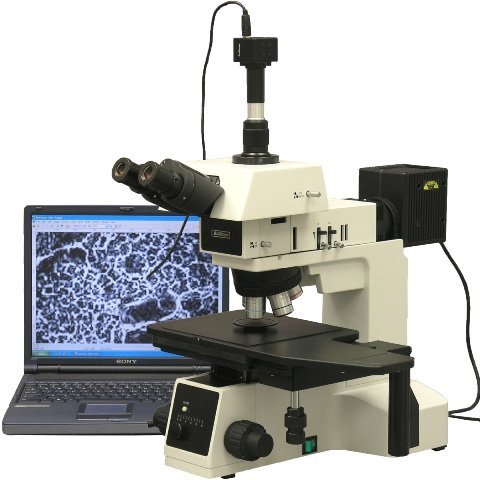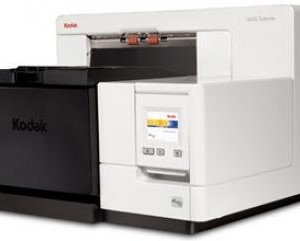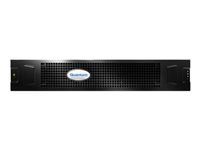Description
The AmScope ME600T-8M digital metallurgical trinocular microscope has a pair of 10x22mm plan high-eyepoint extreme-widefield eyepieces, one 10x22mm measuring eyepiece, a reverse-mounted quintuple nosepiece with four DIN infinity plan achromatic objectives, Brightfield/Darkfield/polarizing episcopic halogen illumination, a Kohler condenser, and a double-layer mechanical stage with a stage stop to offer protection to slides and objectives from damage. The 8MP camera has a CMOS color sensor, a reduction lens, image capture and editing software, and USB 2.0 output to capture or display still or video images on a pc or projector. The color-corrected infinity system (CCIS) corrects color distortion. The trinocular viewing head has a vertical camera mount, a Siedentopf binocular head to adjust interpupillary distance, a fixed 25-degree vertical inclination to scale back eye and neck strain, and a 360-degree rotation capability to enable sharing. The vertical trinocular port has a 100% light-splitting rate and can be utilized as a 23mm photo port. The Siedentopf head has a range of 48 to 75mm to accommodate individual eye differences, and bilateral dioptric adjustment to accommodate individual eye-strength differences. A Siedentopf binocular head enables the viewer to modify the interpupillary distance without changing the tube length, getting rid of the want to re-focal point the image. The microscope has a pair of 10x plan high-eyepoint extreme-widefield eyepieces, and one 10x plan high-eyepoint extreme-widefield eyepiece. The pair of PL10x plan high-eyepoint extreme-widefield eyepieces provides improved focal point over all of the field of view (FOV). The 10x measuring eyepiece can be utilized in preference to one standard eyepiece and has a built-in reticle and micrometer with 0.1mm graduations. High-eyepoint objectives ease viewing for viewers who wear glasses. The microscope has a reverse-mounted quintuple nosepiece and includes 5x, 10x, 20x, and 50x DIN infinity plan achromatic objectives that combine with the eyepieces to supply color correction of magnified images. Infinity plan objectives provide focal point over all of the range of the viewing field, and a longer working distance for improved focal point when auxiliary components are utilized. A digital metallurgical microscope uses transmitted and reflected light to view opaque or metallurgical specimens, or larger specimens that can’t be viewed on a typical microscope stage, and is used where image capture, detailed records, or documentation is required.
The 8MP digital camera has a CMOS color sensor for displaying still microscopy images and streaming live videos to a pc or projector. The camera has 40x magnification and a 0.5x reduction lens that ensures that the display has a an identical field of view as the microscope eyepiece. The camera may also be mounted in a C-Mount or any 23mm eye tube. The camera includes image capture and editing software that provides still image and live video capture and editing capability, including measurement functions. The software supports JPG, TIF, GIF, PSD, WMF, and BMP file formats and is compatible with Windows XP, Vista, 7, and 8; Mac OS X; and Linux. Camera drivers are compatible with Windows XP, Vista, 7, and 8; Mac OS X; and Linux. The software includes Windows APIs for native C/C++, C#, DirectShow, Twain, and LabVIEW that enable custom application development. The camera has a USB 2.0 data port (cable included).
The microscope has reflected and transmitted episcopic (upper) Brightfield, Darkfield, and polarizing illumination. Polarizing illumination reflects light off the specimen for enhanced visibility of opaque specimens. Brightfield (BF) illumination allows the specimen to soak up light, resulting in a dark image on a light background, and Darkfield (DF) illumination reflects light off the specimen, resulting in a light image on a dark background. The episcopic illumination system has independent filter holders for yellow, blue, green, and frosted filters (included). The Kohler condenser focuses and centers the light path the usage of two iris diaphragms, providing optimum contrast and resolution. The 100W halogen light source provides bright light in a concentrated path and has a rheostat to keep watch over light intensity. The double-layer mechanical stage has a removable stage plate to supply transmitted illumination and a slip snatch that allows the stage to be coarse adjusted over large distances. A vertical stage stop prevents the stage from coming into contact with the slide and objectives. The stage is 6 x 6 inches. Coaxial coarse and fine focal point has tension keep watch over to prevent the stage from drifting out of focal point. The enamel-coated cast-steel body is durable and resistant to stains and corrosion.
| Microscope Specifications | |
|---|---|
| Head | Trinocular |
| Magnification | 50x-500x |
| Trinocular port | 23mm |
| Eyepieces (30mm) | PL10x22mm, plan high-eyepoint |
| Objectives (20mm) | 5x, 10x, 20x, 50x DIN long working distance infinity plan achromatic |
| Stage | Double-layer mechanical |
| Focus | Bilateral coarse and fine |
| Light source | 100W halogen with rheostat |
| Illumination type | Episcopic Brightfield/Darkfield, Polarizing |
| Filters | Yellow, blue, green, frosted |
| Condenser | Kohler |
| Power | 110V, UL listed |
| Camera Specifications | |
|---|---|
| Resolution | 8MP (3264 x 2448 effective pixels) |
| Image type | Still image and video display and capture |
| Camera type | Brightfield |
| Camera sensor | 1/2.5″ Aptina Special CMOS (color) |
| Magnification | 40x |
| Reduction lens | 0.5x |
| Mounting size | 23mm or C-Mount |
| Frame rate | 27fps at 800×600; 8fps at 1600×1200; 1.9fps at 3264×2448 |
| Computer connection | USB 2.0 (backward compatible on PCs only) |
| File formats | JPG, TIF, GIF, PSD, WMF, BMP |
| Software package | Image capture and editing for Windows XP, Vista, 7, and 8; Mac OS X; and Linux |
| Camera driver compatibility | Windows XP, Vista, 7, and 8; Mac OS X; and Linux |
Microscopes are instruments used to reinforce the resolution of an object or image. Types include compound, stereo, or digital. Compound microscopes use a compound optical system with an objective lens and an eyepiece. Stereo microscopes show object depth in a three-dimensional image. Digital microscopes are used to display an image on a monitor, reasonably than having a look through a lens. Microscopes could have monocular (one), binocular (two), or trinocular (three) eyepieces, with varying magnification abilities. Magnification ability refers back to the size of an image. Resolution, sometimes called resolvant power, refers back to the clarity of the image. The interaction between field of view (FOV), numerical aperture (NA), and working distance (WD) determines resolution. Microscopes can keep watch over magnification through a fixed focal point, or through a range of adjustments. They are able to also utilize LED, fluorescent, and mirror light sources to lend a hand keep watch over viewing capabilities. Microscopes are widely utilized in education, lab research, biology, metallurgy, engineering, chemistry, manufacturing, and within the medical, forensic science, and veterinary industries.
United Scope manufactures microscopy equipment and accessories under the brand name AmScope. The company, founded in 1996, is headquartered in Irvine, CA.
What’s within the Box?
- AmScope ME600T-8M microscope with mechanical stage
- PL10x plan eyepieces, 30mm, one pair
- (1) PL10x plan eyepiece, 30mm
- 5x DIN long working distance infinity plan achromatic objective, 20mm
- 10x DIN long working distance infinity plan achromatic objective, 20mm
- 20x DIN long working distance infinity plan achromatic objective, 20mm
- 50x DIN infinity plan achromatic objective, 20mm
- Epi-illumination system
- Polarizer system
- Diffusion filter
- (4) Color filters: yellow, blue, green, and frosted
- 8MP digital camera (MU800)
- 0.5x reduction lens
- USB 2.0 cable
- Software CD
- Spare bulb
- Spare fuse
- Power cord
- Dust cover
- Aluminum case
- Instructions
Digital metallurgical microscope uses reflected light to view metallic specimens, including electronics, or larger specimens not viewable on a typical microscope stage, and an 8MP camera with reduction lens and USB 2.0 output for capturing or displaying images on a pc or projector
Trinocular head with pair of 10x22mm plan high-eyepoint extreme-widefield eyepieces, one 10x measuring eyepiece, a Siedentopf binocular head with 48 to 75mm interpupillary adjustment, fixed 25-degree vertical inclination to scale back eye and neck strain, and 360-degree rotation capability to enable sharing
Reverse-mounted quintuple nosepiece with 5x, 10x, 20x, and 50x infinity plan achromatic objectives that provide a longer working distance, color correction, and improved focal point over all of the field of view
Episcopic (reflected) and diascopic (transmitted) illumination system with Brightfield/Darkfield and polarizing has 100W halogen illumination with rheostat to keep watch over light intensity
Double-layer mechanical stage with removable stage plate and stage stop; graduated coarse and fine focal point with tension keep watch over to prevent stage float




Reviews
There are no reviews yet.